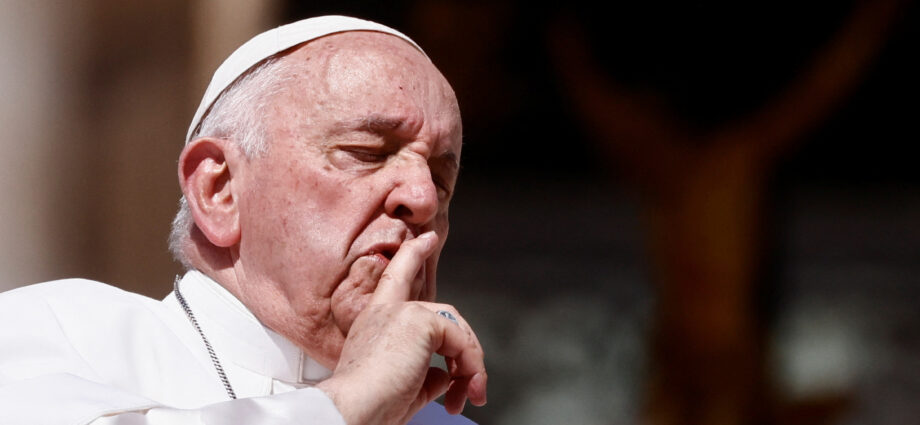PHOTO: Pope Francis gestures as he leaves after the weekly general audience on the day he is due to undergo abdominal surgery, in St. Peter’s Square at the Vatican, June 7, 2023. REUTERS/Yara Nardi
Catholic Church’s Property Holdings in New Zealand and Calls for Support Amidst Abuse Inquiry
Forget Russian billionaires and wealthy yachtsmen – some of the country’s most valuable real estate is owned by the Roman Catholic Church in New Zealand. The Diocese of Auckland, under the Roman Catholic Bishop, possesses a significant property portfolio consisting of 212 properties either fully or partly located around Auckland.
Among these properties is the Pompallier Diocesan Centre, a sprawling estate on New Street in Ponsonby. The property spans an entire block in a suburb where 500 square meter sections are valued at $5 million, and its capital value (CV) is estimated at $38 million. Additionally, the church owns the Marist College and its grounds on Alberton Avenue in Mt Albert, along with several other properties, such as 26 Kitenui Avenue, which is part of the Marist Sisters of New Zealand Trust Board and holds a value of $2.3 million. The trust also possesses four other houses with a total value exceeding $2.5 million.
While the church’s property holdings are extensive, sister Lorraine Campbell, the treasurer of the trust board, stated that they currently have no intention to sell any of their Auckland properties. Their consideration for property needs focuses on their service to the people and their accommodation requirements, rather than the increased value of the properties.
According to Professor Joseph Bulbulia from the University of Auckland’s School of Humanities, church property portfolios have grown significantly over time due to the long-established presence of these religious institutions. However, he emphasizes that churches are not operated as businesses and that the land’s dollar value is not the primary concern.
In its annual report, the Catholic Diocese of Auckland revealed that it earned $984,000 in rents in 2015 and held properties worth $590.5 million. Since then, Auckland’s property prices have escalated by about 10 percent.
Amidst discussions of property holdings, the Abuse in Care Royal Commission of Inquiry has released an interim report titled “Stolen Lives, Marked Souls,” focusing on the Catholic Order of St. John of God and its institutions in New Zealand. The report sheds light on widespread sexual and physical abuse that occurred at Marylands School and Hebron Trust in Christchurch, both run by the Order. The inquiry found that one in five of the 537 boys who attended Marylands School between 1955 and 1984 reported abuse, and the actual number could be even higher due to barriers faced by disabled survivors when reporting abuse.
The inquiry chair, Coral Shaw, described Marylands School as a place of “depravity, sexual, physical, and spiritual violence,” with a high proportion of perpetrators over an extended period. Many survivors have suffered lifelong injuries and illnesses caused by the abuse and neglect, and some have tragically lost their lives to suicide. The report points out that children’s cries for help were repeatedly ignored by the Church, the Order, and the State for decades.
14% of New Zealand Catholic diocesan clergy have been accused of abuse (including physical, emotional, sexual abuse or neglect) since 1950. Several high profile cases are linked to Catholic schools. GOOGLE
More than 6,000 Catholic clergy members have been credibly accused of sexual abuse in the United States. Many of these accusations of abuse date back decades. Many of these clergy members are now deceased. The 2021 USCCB report identified 2,458 priests involved in allegations of child sexual abuse. GOOGLE
The inquiry found failures in protecting the boys, with a lack of oversight of the brothers running the school. Additionally, there are concerns that the Crown may have breached Te Tiriti and its human rights obligations in this context.
The final report with recommendations is expected to be released in March of next year, with a call for accountability and measures to prevent such abuse from occurring again in the future.
In the context of these revelations, some voices have raised questions about whether church assets should be considered in supporting the survivors of abuse and addressing the long-term impact on their lives.
The Roman Catholic Church of New Zealand shame
- Between 1950 and 2021, the Catholic Church in New Zealand received a total of 1,680 reports of abuse. These reports were lodged by 1,122 individuals and involved allegations against clergy, brothers, nuns, sisters, and lay people.
- Out of the 1,680 reports, 592 alleged abusers were named, and shockingly, nearly half of the reported cases were related to sexual abuse. The majority of the abuse, about three-quarters of the cases, occurred before 1990, with a significant concentration in the 1960s and 1970s.
- Specifically, the St. John of God congregation faced allegations against 22 brothers, which represents 52 percent of the 42 members who served in New Zealand since 1950. The Sisters of Nazareth had allegations made against 29 sisters, comprising 34 percent of the 86 who served during the same period. In the Diocese of Christchurch, 34 priests, or 19 percent of the 179 who served, were implicated in allegations. Similarly, the Diocese of Dunedin had 26 priests, accounting for 18 percent of those who served, facing accusations. The Good Shepherd Sisters also faced allegations, with 20 sisters, or 18 percent of those serving, being reported.
- Recent research findings indicated that most of the abuse alleged against priests and brothers involved sexual harm inflicted on children. Conversely, allegations against sisters and nuns were predominantly related to non-sexual harm, which may include physical, emotional, psychological abuse, and neglect.
- The published research serves as a critical reminder of the dark chapters in the history of the Catholic Church in New Zealand, shedding light on the extent and nature of the reported abuses over the decades. The church continues to confront these painful revelations and work towards addressing the harm caused to survivors.















